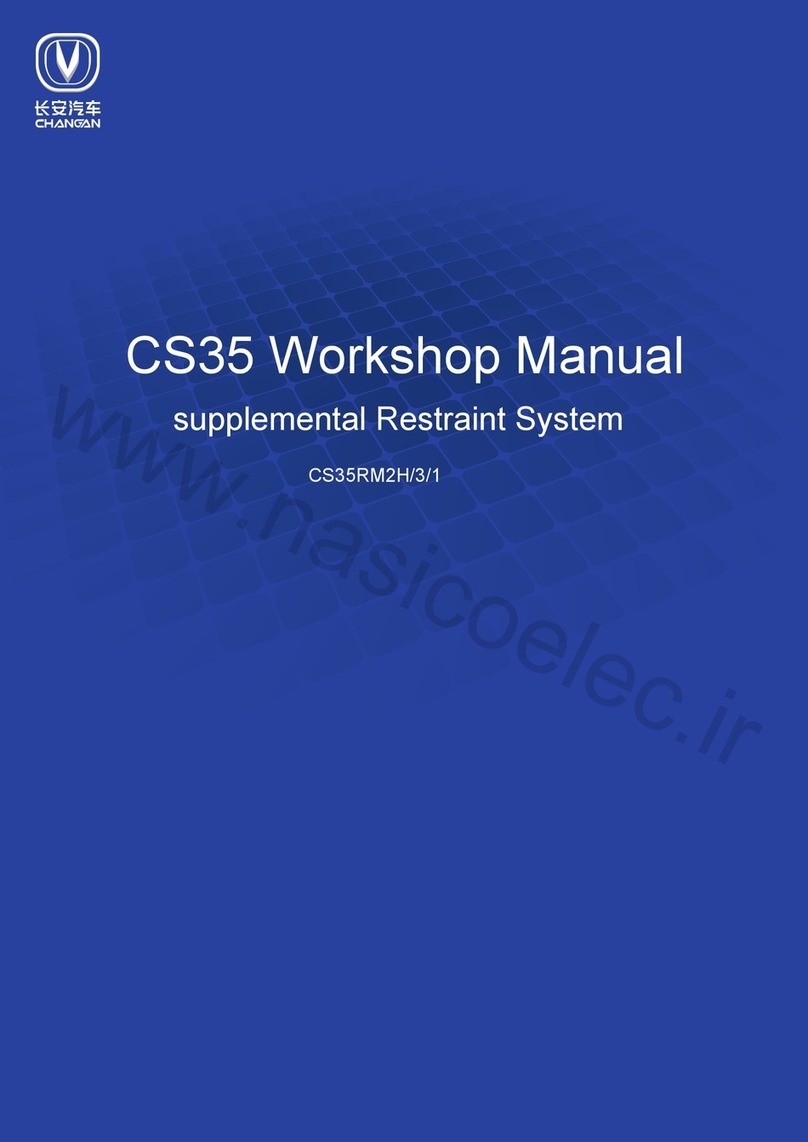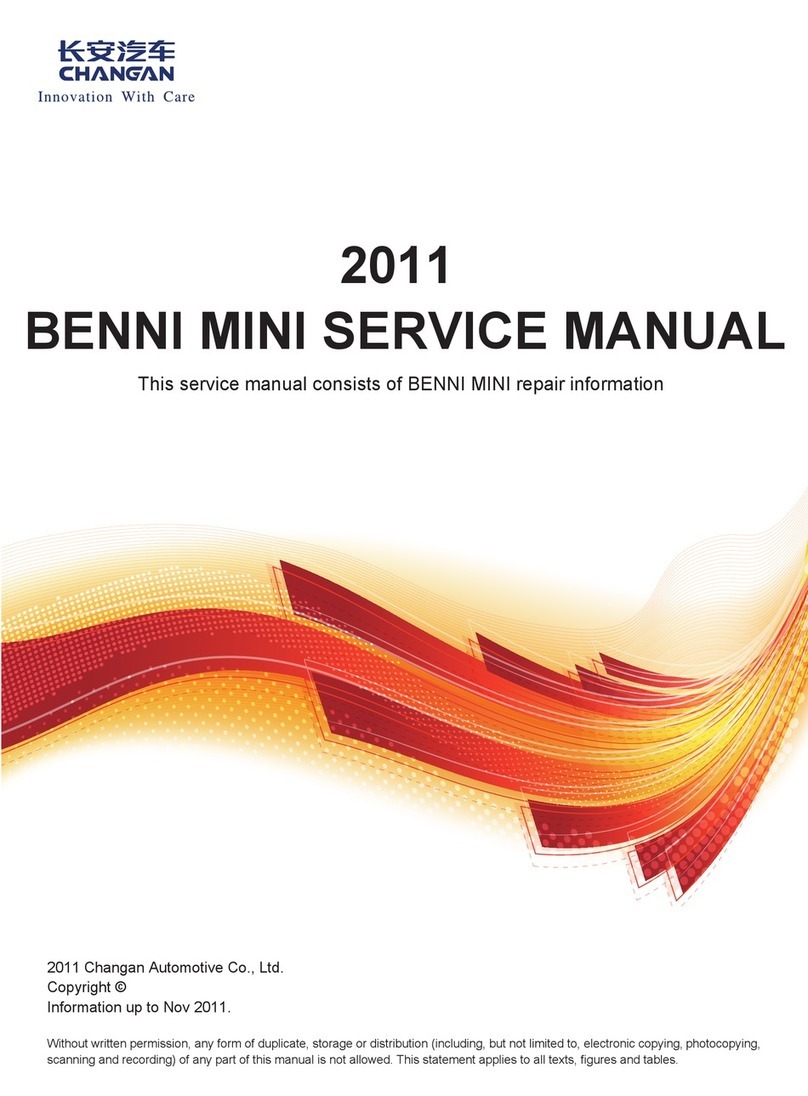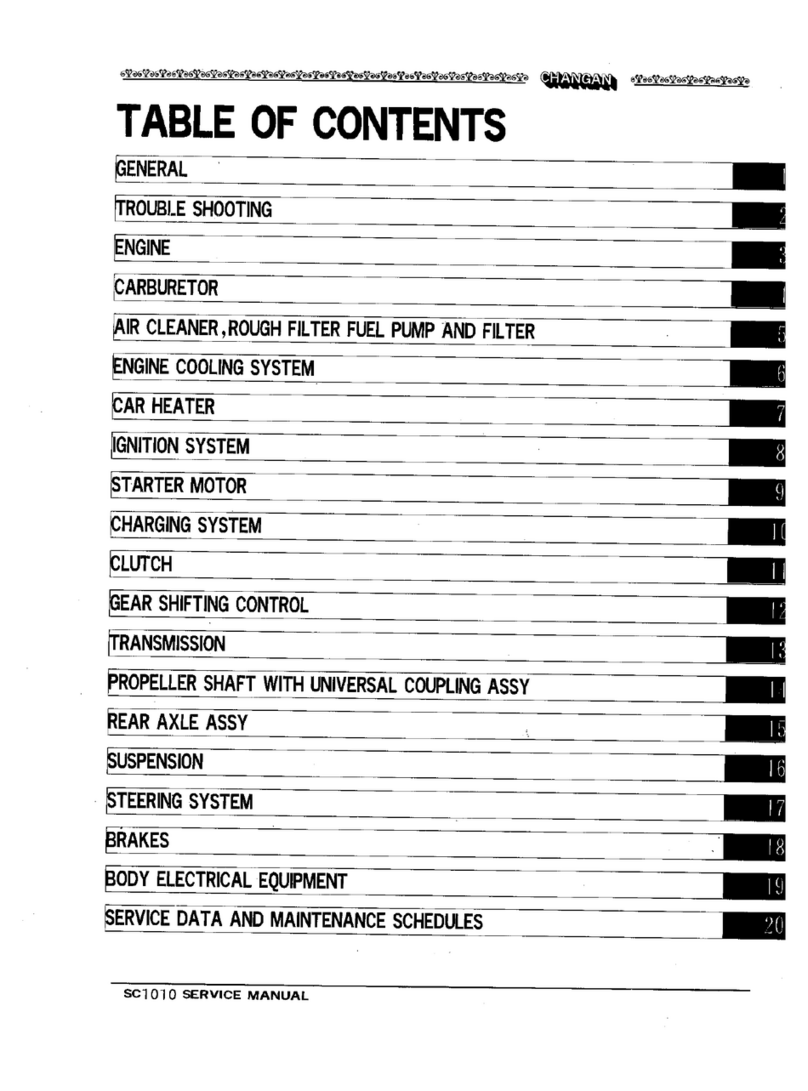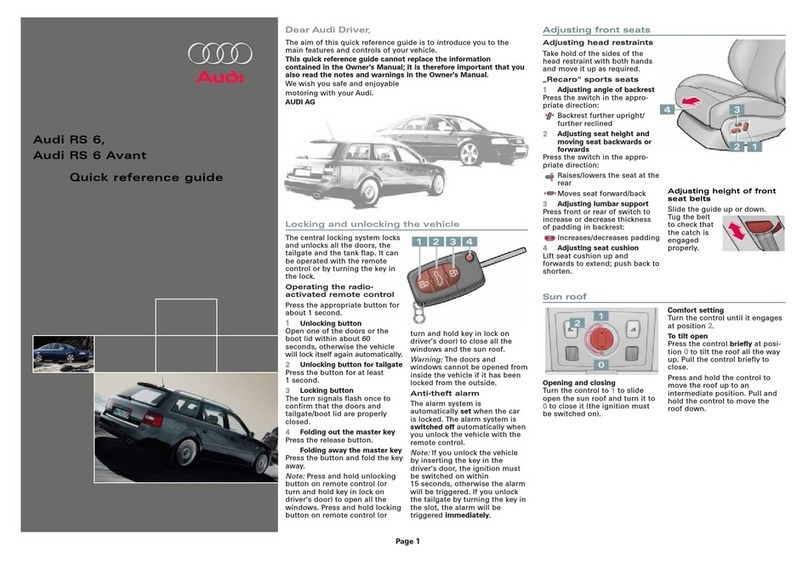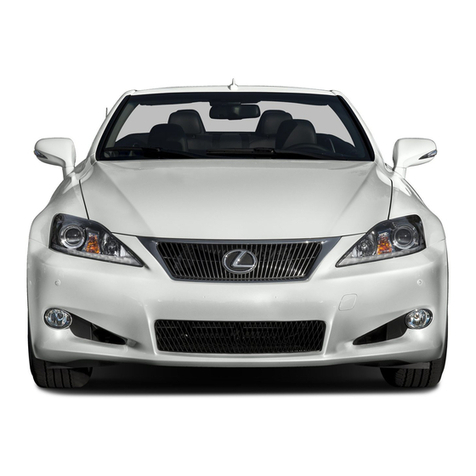Changan CS35 Instruction manual

CS35 Workshop Manual
mashinesoft.com
09120146259
Electronic Control System - ME7
&
Engine Immobilizer System
CS35RM2H/2/1

mashinesoft.com
09120146259

CS35 2013.04
Powertrain
3
GROUP
3.1 Engine - 1.6L
3.1.12 Engine Immobilizer System .......................................................................................... 3.1.12-1
3.1.13 Electronic Control System............................................................................................. 3.1.13-1
SECTION TITLE PAGE
mashinesoft.com
09120146259

mashinesoft.com
09120146259

CS35 2013.04
3.1.12-1 3.1.12-1Engine Immobilizer System
Specifications
Torque Specifications
Name Nm lb-ft lb-in
ECM retaining bolt 10 - 89
BCM retaining bolt 11 8 -
3
.
1
.
12
E
ng
i
ne
I
mmo
bili
zer
S
ys
t
em
mashinesoft.com
09120146259

3.1.12-2
CS35 2013.04
3.1.12-2Engine Immobilizer System
Description and Operation
System Overview
On the vehicles with engine immobilizer control-
ler , if you want to start the engine, the starter
key (password transponder) shall pass through
the ELF magnetic fields and the body control
module validation. If the body control module
validation of the starter key (password transpon-
der) fails, the engine control module obtains the
vehicle fortification not releasing information
from the body control module by K-Line network,
turn the ignition key to the "ST" position, and the
engine can not be started.
Engine immobilizer system consists of the follow-
ing main components:
1. Password transponder (remote key)
2. Immobilizer controller (IMMO)
3. Body control module (BCM)
4. Engine control module (ECM)
When the ignition switch is at "ON" position, the
password transponder of the key passes through
the ELF magnetic fields and the body control
module for validation. After the successful valida-
tion, the body control module communicates with
the engine control module via K-Line network,
allowing the engine control module to start the
engine.
mashinesoft.com
09120146259

CS35 2013.04
3.1.12-3 3.1.12-3Engine Immobilizer System
System Principle
BCM
Immo
Module
Engine
Management
Module
Transponder
O-L
O-L
O-H
O-H
LF
K-Line
LIN
IGN ON
Key in detection
KL30
KL30
I-D-H
I-D-H
Security LED
Immo Power
GROUND(Immo)
Immo IIIumination
ring control
A3112001
mashinesoft.com
09120146259

3.1.12-4
CS35 2013.04
3.1.12-4Engine Immobilizer System
General Procedures
General Equipment
1. Inspect the after-sales rectified devices,
which may affect the engine immobilizer
system.
2. Inspect the easy-to-access or visible system
components, in order to identify whether
there is significant damage or other problems
that may cause failure.
3. If the system displays the engine is locked,
inspect to see whether the ignition key is
learned or perform the learning process of the
ignition key.
Digital multimeter
Changan Auto special diagnostic tester
mashinesoft.com
09120146259

CS35 2013.04
3.1.12-5 3.1.12-5Engine Immobilizer System
Symptom Diagnosis and Testing
General Equipment
Inspection and Verification
1. Verify the customer concern.
2. Visually inspect for obvious signs of
mechanical damage or electric damage.
3. If an obvious cause for an observed or
reported concern is found, correct the cause
before proceeding to the next step.
4. If no obvious problem been found, confirm
the failure and refer to the Symptom Chart.
Visual Inspection Chart
Digital multimeter
Changan Auto Special Diagnostic Tester
Mechanical Electric
• Starter key (password
transponder)
• Circuit
• Immobilizer controller
•ECMcircuit
•BCMcircuit
• IPC circuit
mashinesoft.com
09120146259

3.1.12-6
CS35 2013.04
3.1.12-6Engine Immobilizer System
Symptom Chart
If there is symptom but no diagnosis trouble code (DTC) is stored in control module and can not confirm
symptom reasons in basic inspect, it is necessary to diagnosis and eliminate the symptoms in the follow-
ing chart.
Symptom Possible Sources Action
The key cannot match
•Keyassembly
• Immobilizer controller
•BCM
• Inspect and replace the key assembly.
• Match the remote key.
• Inspect the circuit.
• Inspect and replace the BCM.
ECM always detect that the immobilizer
is enabled
• Wiring harness
•Keyassembly
• Immobilizer controller
•ECM
•BCM
Refer to: ECM Always Detect
That Immobilizer Is Enabled
Fault Diagnosis (3.1.12 Engine
Immobilizer System, Symptom
Diagnosis and Testing).
mashinesoft.com
09120146259

CS35 2013.04
3.1.12-7 3.1.12-7Engine Immobilizer System
ECM Always Detect That Immobilizer Function Activated Diagnosis
Test conditions Details/Results/Actions
1. Re-match the remote controller
CAUTION: If BCM does not match the keys
on line or manually before, the original
password is 0000.
A.Turn the ignition switch to "ON" position.
B.Connect the diagnostic tool wiring harness to the
vehicle interface.
C.Select : "Changan Auto" / "CS35" / "Delphi BCM" /
"Safe operation" / "Enter password" / "Enter safe
operation" / "Anti-theft key matching" / "Start
matching"on the diagnostic tool.
D.Starting the engine.
Does the engine start normally?
Y
Verify the system is normal.
N
Go to step 2.
2. Inspect the power supply circuit of the immobilizer controller
A.Turn the ignition switch to position "LOCK".
B. Disconnect the immobilizer controller wiring
harness connector P10.
C.Turn the ignition switch to position "ON".
D.Measure the voltage between terminal 1 of
immobilizer controller wiring harness connector P10
and reliable ground with the multimeter.
Standard Voltage Value: 11 ~ 14 V
Is the voltage normal?
Y
Go to step 3.
N
Inspect and repair the power supply circuit of the
immobilizer controller.
P10
14
A3112010
mashinesoft.com
09120146259

3.1.12-8
CS35 2013.04
3.1.12-8Engine Immobilizer System
3. Inspect the Lin network circuit of the immobilizer controller
A.Turn the ignition switch to position "LOCK".
B.Disconnect the battery negative cable.
C.Disconnect the wiring harness connector P24 of the
body control module and the wiring harness
connector P10 of the immobilizer controller.
D.Measure the resistance value between the terminal
3 of the BCM wiring harness connector P24 and the
terminal 3 of the immobilizer controller wiring
harness connector P10 with a multimeter.
Standard Resistance Value: less than 5 Ω
Is the resistance value normal?
Y
Go to step 4.
N
Inspect and repair the open circuit between the ter-
minal 3 of the BCM wiring harness connector P24
and the terminal 3 of the immobilizer controller wir-
ing harness connector P10.
4.Inspect the immobilizer controller ground circuit
A.Turn the ignition switch to position "LOCK".
B.Disconnect the body control module wiring harness
connector P10.
C.Measure the resistance between terminal 2 of
immobilizer controller wiring harness connector P10
and reliable ground with the multimeter.
Standard Resistance Value: less than 5 Ω
Is the resistance value normal?
Y
Go to step 5.
N
Inspect and repair the ground circuit of the immobi-
lizer controller.
Test conditions Details/Results/Actions
P24
10 1
20
3
11
P10
134
A3112011
P10
124
A3112012
mashinesoft.com
09120146259

CS35 2013.04
3.1.12-9 3.1.12-9Engine Immobilizer System
5. Inspect the K-line network cable between ECM and BCM
A.Turn the ignition switch to position "LOCK".
B.Disconnect the battery negative cable.
C.Disconnect the wiring harness connector P24 of the
body control module and the ECM wiring harness
connector E01.
D.Measure with multimeter the resistance between the
terminal 2 of BCM wiring harness connector P24
and the terminal 71 of the ECM wiring harness
connector E01.
Standard Resistance Value: less than 5 Ω
Is the resistance value normal?
Y
Go to step 6.
N
Repair the open circuit terminal 2 of BCM wiring
harness connector P24 and terminal 71 of the ECM
wiring harness connector E01.
6. Replace the password transponder
A.Replace the password transponder of the remote
key, and rematch the key.
Is the system normal?
Y
Verify the system is normal.
N
Go to step 7.
7. Inspect the ECM power supply circuit
A.Turn the ignition switch to position "LOCK".
B.Measure from the back of ECM wiring harness
connector E01.
C.Turn the ignition switch to "ON" position and use a
multimeter to measure the voltage between the
terminal 12, 13, 44, 45 and 63 of the ECM wiring
harness connector E01 and the power supply.
Standard Voltage Value: 11 ~ 14 V
Is the voltage normal?
Y
Go to step 8.
N
Repair and inspect the ECM power supply circuit.
Test conditions Details/Results/Actions
P24
10 1
20
2
11
E01
12
3
45 624
25
71
43
4462
6381
A3112014
12
3
45 624
2543
4462
63
13 12
45
81
E01
A3113031
mashinesoft.com
09120146259

3.1.12-10
CS35 2013.04
3.1.12-10Engine Immobilizer System
8.Inspect the ECM ground circuit
A.Turn the ignition switch to position "LOCK".
B.Measure from the back of ECM wiring harness
connector E01.
C.Measure with a multimeter the resistance between
the ECM wiring harness connector E01 terminal 3,
51, 53, 61 and 80 and the reliable ground.
Standard Resistance Value: less than 5 Ω
Is the resistance value normal?
Y
Go to step 9.
N
Inspect and repair the ECM ground circuit.
9. Replace the ECM
A.Replace the ECM.
Refer to: Engine Control Module (3.1.13
Electronic Control System - ME7, Removal
and installation).
Is the system normal?
Y
Verify the system is normal.
N
Go to step 10.
Test conditions Details/Results/Actions
12
3
45 6
51
53
61
80
24
2543
4462
6381
E01
A3113032
mashinesoft.com
09120146259

CS35 2013.04
3.1.12-11 3.1.12-11Engine Immobilizer System
10. Inspect the BCM power supply circuit
A.Turn the ignition switch to position "LOCK".
B.Disconnect the battery cathode cable.
C.Disconnect the body control module wiring harness
connector P14, P23.
D.Connect the battery negative cable.
E.Turn the ignition switch to position "ON".
F.Measure the voltage between the terminal 2, 4, 16,
19 body control module wiring harness connector
P14, and terminal 1 of P23 and the reliable ground.
Standard Voltage Value: 11 ~ 14 V
Is the voltage normal?
Y
Go to step 11.
N
Inspect and repair the BCM power supply circuit.
Test conditions Details/Results/Actions
P14
1
2
3
4
6
7
9
10
12
13
15
16
18
19
21
A3112005
P23
10
20
1
11
A3112013
mashinesoft.com
09120146259

3.1.12-12
CS35 2013.04
3.1.12-12Engine Immobilizer System
11. Inspect the BCM ground circuit
A.Turn the ignition switch to position "LOCK".
B.Disconnect the battery negative cable.
C.Disconnect the body control module wiring harness
connector P14, P25.
D.Measure the resistance between terminal 1, 3, 12
and 13 of the BCM wiring harness connector P14
and terminal 19 of P25 and the reliable ground.
Standard Resistance Value: less than 5 Ω
Is the resistance value normal?
Y
Go to step 12.
N
Inspect and repair the BCM ground circuit.
12.Replace the BCM
A.Replace the BCM.
Refer to: Body Control Module (4.3.14
Body Control System, Removal and Instal-
lation).
Confirm the repair is finished.
Test conditions Details/Results/Actions
P14
1
2
3
4
6
7
9
10
12
13
15
16
18
19
21
A3112008
P25
10 1
20 19 11
A3112009
mashinesoft.com
09120146259

CS35 2013.04
3.1.13-1 3.1.13-1Electronic Control System - ME7
Specification
Torque Specifications
Description Nm lb-ft lb-in
Intake pressure temperature sensor retaining bolt 10 - 89
Spark plug 23 17 -
Throttle body retaining bolt 13 10 -
Engine control module retaining bolt 10 - 89
Crankshaft position sensor retaining bolt 10 - 89
Camshaft position sensor retaining bolt 10 - 89
Engine coolant temperature sensor bolt 20 15 -
Fuel distribution pipe assembly retaining bolt 23 17 -
Upstream oxygen sensor 50 37 -
Downstream oxygen sensor 50 37 -
Knock sensor retaining bolt 20 15 -
Accelerator pedal position sensor retaining screw 23 17 -
Oil control valve 10 - 89
3
.
1
.
13
El
ec
t
ron
i
c
C
on
t
ro
l
S
ys
t
em -
ME7
mashinesoft.com
09120146259

3.1.13-2
CS35 2013.04
3.1.13-2Electronic Control System - ME7
Description and Operation
System Overview
Electrical control system is consisted of the following components:
1. Various sensors that judge the engine status and operation condition.
2. Engine control module that controls each actuator of EFI system based on the signal of each sensor.
3. Various electronic control actuators.
4
18
19
20
21
22
10
12
1
2
35
67
9
8
11
13
14
15
16
17
A3113001
mashinesoft.com
09120146259

CS35 2013.04
3.1.13-3 3.1.13-3Electronic Control System - ME7
Item Description Item Description
1 Carbon canister 12 Water temperature sensor
2 Electronic throttle body 13 Knock sensor
3 Carbon canister control valve 14 Crankshaft position sensor
4Air intake pressure temperature
sensor 15 Fuel pressure regulator
5 Fuel distribution pipe 16 Electronic fuel pump
6 Ignition coil and spark plug 17 Accelerator pedal
7 Camshaft position sensor 18 Anti - burglary
8 Oil control valve 19 Diagnostic interface
9 Pre - catalytic oxygen sensor 20 Fault indicator
10 Three-way catalytic converter 21 CAN
11 Post - catalytic oxygen sensor 22 Electronic control unit (ECU)
mashinesoft.com
09120146259

3.1.13-4
CS35 2013.04
3.1.13-4Electronic Control System - ME7
According to the performance, the
electrical control system can be
divided into the following subsystems
• Fuel injection control system
• Idle speed control system
• Fuel pump control system
• Ignition timing control system
• Radiator fan control system
• Fuel steam emission control system
• A/C control system
• DVVT control system
ME7 System Input / Output Signal
The main sensor input signals of ECM of ME7
system include:
• EFP signal
• Airflow signal
• Throttle rotor angle signal
• Coolant temperature signal
• Engine speed signal
• Phase signal
• Knock sensor signal
• Oxygen sensor signal
• Vehicle speed signal
• A/C pressure signal
After the above information goes into ECM, they
are been processed then the required actuator
control signals are generated, these signals are
amplified in the output driver circuit, and are
transmitted to each corresponding actuator, these
control signals include:
• Electronic throttle motor
• Injection timing and injection duration
• Fuel pump relay
• Carbon canister control valve opening
• Ignition coil dwell angle and spark
advance angle
• A/C compressor relay
• Cooling fan relay
• Oil control valve
Fuel Injection Control
ECM controls the injection time and the injection
timing from injector to the cylinder head intake
port based on various sensors signals, to ensure
the appropriate mixed gas is provided in different
driving conditions. There are two forms of injec-
tion timing, one is synchronous injection, which
always injects at the same crankshaft angle, the
other is non - synchronous injection, which is con-
trolled based on inlet pressure temperature sen-
sors and other sensor signals.
1. Synchronous injection
When the engine starts, the air in the intake
manifold is still, the internal pressure of the
intake manifold shows as the surrounding
atmospheric pressure. Electrical throttle
opens to a certain angle based on a fixed
parameter that determined by the starting
temperature. 4 injectors will inject synchro-
nously in each cycle. Fuel injection amount
varies according to the engine temperature.
Before the engine reaches a certain speed,
the mixture need to be enriched. Once the
engine is running, the system immediately
begins to reduce the cranking enrichment,
until the end of starting (600 ~ 700 rpm), start
enriching is completely canceled.
2. Non - synchronous injection
After engine starts and the following condi-
tions are met, all fuel injectors will not be con-
trolled by the pressure / temperature sensor.
• Fuel injection system starts to inject when
fuel is disconnected.
• When the throttle opening rate is higher
than the specified value (throttle opens
too fast).
Non - synchronous injection system is gener-
ated quickly under above two situations.
3. Injection time
The main elements of identifying the fuel
injection time is based on the basic injection
time value thatcalculated according to the
engine speed, the intake manifold pressure
temperature (air intake flow rate), and a vari-
ety of the compensation value that is deter-
mined by the sensor signals which is used for
mashinesoft.com
09120146259
Other manuals for CS35
1
Table of contents
Other Changan Automobile manuals
